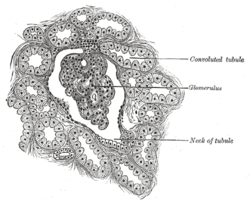Distal Convoluted Tubule
| Distal convoluted tubule | |
|---|---|

Kidney nephron ("1st proximal convoluted tubule", "2nd distal convoluted tubule")
|
|

Section of cortex of human kidney.
|
|
| Details | |
| Precursor | Metanephrogenic blastema |
| Identifiers | |
| Latin | tubulus contortus distalis |
| MeSH | Distal+Kidney+Tubule |
| Dorlands /Elsevier |
12830066 |
| FMA | 17721 |
|
Anatomical terminology
[]
|
|
The distal convoluted tubule (DCT) is a portion of kidney nephron between the loop of Henle and the collecting duct system.
It is partly responsible for the regulation of potassium, sodium, calcium, and pH. It is the primary site for the kidneys' hormone based regulation of calcium (Ca).
On its apical surface (lumen side), cells of the DCT have a thiazide-sensitive Na-Cl cotransporter and are permeable to Ca, via the TRPV5 channel. On the basolateral surface (blood) there is an ATP-dependent Na/K antiporter pump, a secondary active Na/Ca transporter, and an ATP dependent Ca transporter. The basolateral ATP dependent Na/K pump produces the gradient for Na to be absorbed from the apical surface via the Na/Cl symporter, and for Ca to be reclaimed into the blood by the Na/Ca basolateral antiporter.
Thiazide diuretics inhibit Na+/Cl− reabsorption from the DCT by blocking the thiazide-sensitive Na-Cl cotransporter.
By inhibiting the cotransporter, thiazide diuretics increase the gradient potential for Na. This increases the activity of the basolateral Na/Ca antiport and causes the increase in calcium reclamation associated with thiazide diuretics.
The DCT is lined with simple cuboidal cells that are shorter than those of the proximal convoluted tubule (PCT). The lumen appears larger in DCT than the PCT lumen because the PCT has a brush border (microvilli). DCT can be recognized by its numerous , basal infoldings and lateral membrane interdigitations with neighboring cells.
...
Wikipedia
